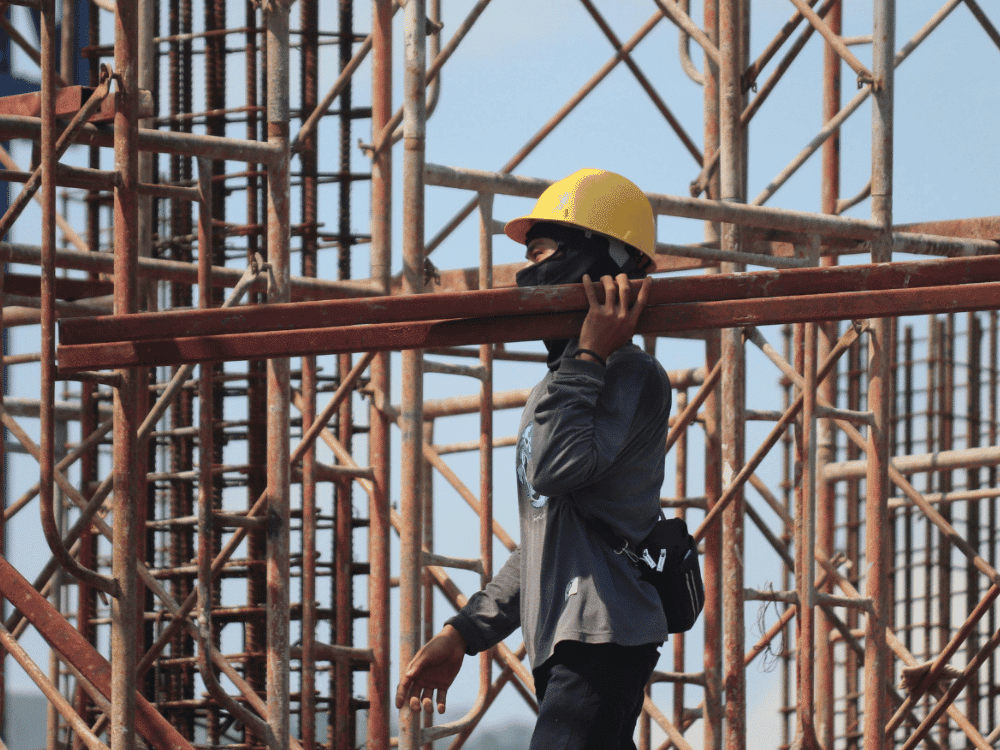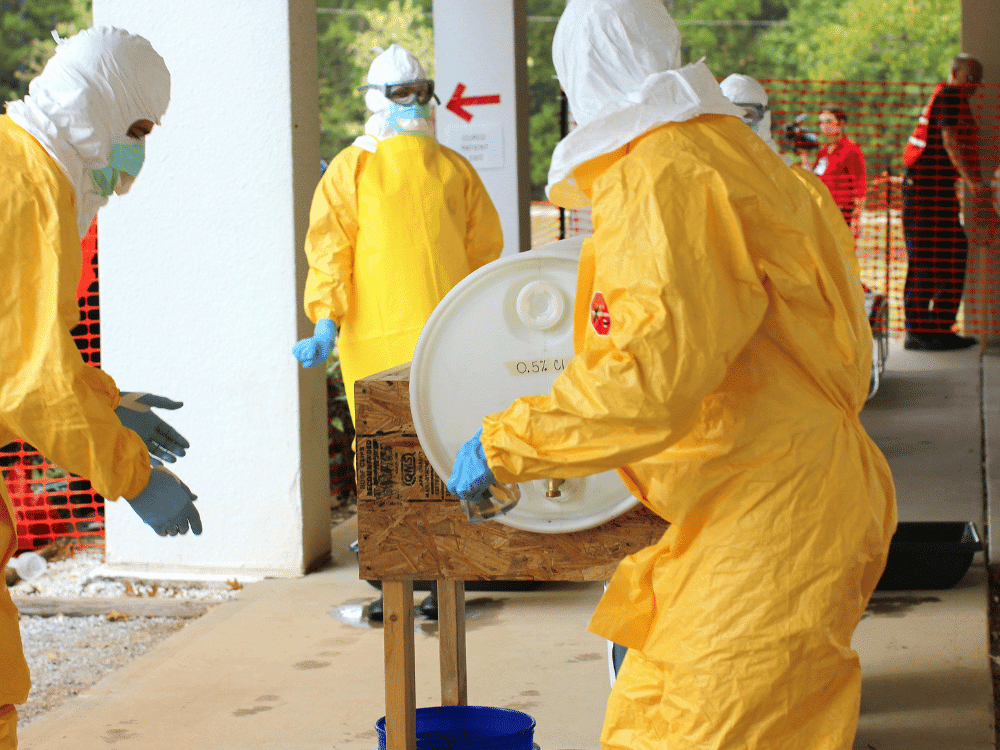Of the 60,645 non-fatal workplace injuries reported by employers in 2022/23, 17% came from manual handling. That’s well over 10,000 professionals – leaving a massive hole in resources.
But what is manual handling? Why is it so dangerous, and how can you help keep your team safe from harm?
Our comprehensive guide will tell you everything you need to know. Plus, we’ll also highlight how our manual handling training course can help drive down the opportunity for incidents to occur in your business.
What is Manual Handling?
The Health and Safety Executive (HSE) says manual handling is when you:
“Transport or support a load by hand or bodily force. It includes lifting, lowering, pushing, pulling, moving, or carrying a load. A load is a moveable object, such as a box or package, a person or an animal, or something being pushed or pulled, such as a roll cage or pallet truck.”
But there’s more to this act, and performing it safely, than simply picking up large or heavy objects.
Several specialist mnemonics have been created over time to help make manual handling in the workplace a safer task. Let’s cover a few of those now.
What Does TILE Stand For in Manual Handling?
TILE in manual handling stands for:
- Task: What is the manual handling task?
- Individual: What are the ability levels of the people performing the task?
- Load: How big or heavy is the object to be handled?
- Environment: What is the layout of the area where the handling will happen? Is it flat and clear from obstructions?
What Does TILEO in Manual Handling Stand For?
The TILEO mnemonic goes one step further than the TILE process, adding an ‘O’ for “Other factors.”
So, this would create T – task, I – individual, L – load, E – environment, and O – other factors.
The ‘Other factors’ element refers to more tailored to specialist manual handling jobs. For example, does the task require Personal Protective Equipment (PPE)? Or do the load characteristics require the added protection of lifting aids?
What Does COG Stand For in Manual Handling?
Aimed more at the person completing the task than the previous mnemonics, CoG stands for “Centre of Gravity.”
It refers to the importance of your centre of gravity when lifting or moving an object. A stable centre of gravity can help prevent falls, trips or slips when carrying a load.
Incidentally, slips, trips and falls accounted for 32% of the work-related non-fatal injuries last year.
What Does AARR Stand For in Manual Handling?
The final mnemonic we’ll cover is AARR. Apart from being a robust way to impersonate a pirate, AARR can also help prevent the most common manual handling injuries.
It stands for:
- Assess: Evaluate the risks associated with the manual handling task.
- Avoid: Does this task need to be carried out? Can it be completed with specialist machinery?
- Review: Was the activity carried out safely? Did everything go smoothly?
- Reduce: Following these steps will help reduce the number of manual handling incidents in your business.
Manual Handling Examples
As mentioned earlier, a good example of manual handling is lifting, lowering, pushing, or pulling an object.
Of course, there are many real-life examples of manual handling in the workplace – any warehouse operative will be confronted with manual handling tasks as part of their daily workload.
However, the key to ensuring worker well-being is clearly defining what is a safe load to bear manually and what tasks should be carried out using mechanical assistance.
There are also numerous examples in locations like farms and construction sites where manual handling is necessary.
However, as the HSE defines construction as the leading sector for fatal injuries at work, it’s essential to remember the above mnemonics when carrying out manual handling tasks at a site.
Why is Manual Handling Important?
Understanding manual handling skills and best practices is incredibly important for preventing many injuries and disorders.
For example, manual handling injuries in the workplace are a leading cause of musculoskeletal disorders (MSDs).
MSDs accounted for over a quarter of the 1.8 million new and long-standing cases of work-related ill health in the UK in 2023.
To put that in further context, 6.6 million working days were lost due to work-related MSDs in 2022/23. So, it pays for employers and workers to have a good understanding of how to complete manual handling tasks safely.
With that in mind, let’s take a closer look at the overriding principles of safe manual handling.
5 Key Principles of Manual Handling
Interestingly, the Manual Handling Operations Regulations 1992 highlight that the best way to reduce manual handling incident rates is to avoid these tasks where possible.
However, there are occasions in the workplace where this is not practicable. In those instances, it pays to employ these five principles for good manual handling techniques:
1. Plan
Before lifting, it’s essential to assert whether your object is moveable. For example, it’s not too heavy or awkwardly shaped. Is it a two-person lift? Then, ensure the path to your destination is clear of obstructions or hazards.
2. Position
Keep your feet apart and put one foot slightly forward to increase your balance (remember CoG). Bend your knees and keep your back straight as you secure a strong grip.
3. Pick
Lift with your legs in a smooth motion – no jerking or twisting.
4. Proceed
Keep the load close to your body and support it without twisting or bending your spine and neck.
5. Place
Lower the object down with that same great posture you picked it up with. Remember a steady, smooth motion on the way down.
Manual Handling Training
If your business requires a good amount of manual handling (or even if it doesn’t), it’s a great idea to enlist the help of specialist training. This targeted coaching will help safeguard the musculoskeletal health of your team.
Can I Get Manual Handling Training?
Anyone can access specialist manual handling training with us at TSW.
With over 50 years of experience delivering health and safety training courses, we cover the core elements of manual handling safety for employers and employees.
Our course is ideal for many professionals, including:
- Construction workers
- Factory and warehouse workers
- Farm and agricultural workers
- Office workers
- Delivery drivers
Can I Get Online Manual Handling Training?
Our manual handling training course can be delivered online via MS Teams or in-house, depending on how you learn best.
How Long Does Manual Handling Certificate Last?
With our dynamic approach to tutoring, you can pass your manual handling training online in just one day.
If your business lies in the sectors outlined above, it could be a good process to add this training for new employees into your health and safety policy to further mitigate incidents related to manual handling.
Manual Handling Regulations Explained
As we alluded to earlier, the rules around safe manual handling operations are defined under the Manual Handling Operations Regulations 1992 (MHOR).
The legislation came into effect on 1 January 1993. Regulation 4 outlines that employers have a responsibility to avoid the need for employees to undertake manual handling tasks that involve a risk of them getting injured.
Manual Handling Operations Regulations 1992 Summary
As we just mentioned, the ideal scenario for manual handling in the view of the MHOR is to avoid the task altogether.
However, the legislation also defines that when these tasks are unavoidable, workers should do two things:
- Assess the hazards and risks associated with the task
- Aim to reduce risk so far as is reasonably practicable.
For completeness, Regulation 5 of the legislation also mandates that employees should use the systems the employer put in place when completing these tasks.
However, to take that one step further, the Health and Safety at Work Act 1974 (HASWA) also defines employees as having a duty to take reasonable care for their own safety and that of others around them in the workplace.
Employees should also cooperate with their employer in all health and safety matters.
What is a Manual Handling Risk Assessment?
A manual handling risk assessment is a check to overview the hazards and risks attached to unavoidable manual handling tasks.
In addition, Regulation 4 of the MHOR also ensures that these vital reviews are a legal requirement. The fines for companies flouting these rules can be severe.
For example, an engineering firm in Norfolk was fined £20,000 in 2017 when a worker crushed two fingers. The welder was carrying a 250kg metal frame with his colleagues when it slipped, trapping his fingers underneath.
How Often Should Manual Handling Assessments Be Updated?
The HSE recommends that manual handling assessments should be reviewed annually. In fact, it’s a good process to review all risk assessments, including your business’s fire risk assessment strategy, every year.
Checking your businesswide assessments annually is a great way to ensure your processes are still up to standard. It can also help to keep your review process compliant with the specific legislation.
What Should Be Considered When Carrying Out a Manual Handling Risk Assessment?
The first thing to say about completing manual handling risk assessments is that they should only be carried out by a competent person. Completing manual handling training can define you as this individual.
Once you have completed the requisite training, you should be clear about assessing your workplace.
Leveraging a hierarchy of control methodology is great for conducting manual handling risk assessments. Simply put, your checks should take into account:
- The task
- Load
- The working environment
- Individual capacity
- Are handling aids required?
- How to allocate work
- The pace of the work
- Frequency and duration of the task
What is a Dynamic Risk Assessment in Manual Handling?
Dynamic risk assessments are critical in manual handling. Because most manual handling tasks vary in terms of the person, load and environment, businesses need to review the safety of the work on a task-by-task basis.
Dynamic risk assessments are more flexible than standard checks as they are required when the details or environment of a particular job change.
In this instance, a dynamic risk assessment should be carried out when handling items of different weights or compositions.
Safe Manual Handling Techniques
As mentioned earlier, good manual handling techniques follow the five core principles.
However, the HSE has also highlighted a good process for manual handling, which should follow the below steps:
- Plan before lifting – define whether you can lift or whether you need assistance from a colleague or machinery.
- Keep the object close to your waist
- Adopt a stable position
- Get a solid grip on the load
- Keep your spine and neck straight
- Avoid twisting or jerking motions
- Move in smooth motions
Manual Handling Injuries
From strains, sprains and general soreness to debilitating disorders, manual handling can cause the onset of numerous injuries.
3 Most Common Types of Manual Handling Injuries
- Back, neck & spine injuries: According to Unison, around 300,000 people suffer from back pain due to manual handling accidents in the UK.
- Musculoskeletal disorders: As we mentioned earlier, MSDs are one of the common risks of manual handling incidents. In fact, NHS figures show these disorders cost the service around £5 billion annually.
- Hernias: Incorrectly handling heavy loads can cause pressure to build up throughout your body. Hernias come as a result of this pressure and muscular weaknesses.
Frequently Asked Questions (FAQs)
Here are some frequently asked questions about manual handling.
What Are Manual Handling Hazards?
The most common manual handling hazards are musculoskeletal disorders. But injuries like strains, sprains, and hernias are also commonplace.
What is the Hierarchy of Manual Handing?
The hierarchy of manual handling consists of five key steps:
- Elimination: Avoiding the need to move the load manually altogether.
- Substitution: Reducing the risk by splitting the load into smaller chunks or calling multiple employees for assistance.
- Engineering controls: Leveraging mechanical assistance to move the load instead.
- Admin controls: Providing appropriate manual handling training.
- PPE: Mitigating the risk by using protective equipment like gloves, non-slip footwear and steel toecap boots.
This framework can be administered to carry out a manual handling task safely or when completing a manual handling risk assessment.
What is the Manual Handling Maximum Weight?
There is no legal maximum weight that a person can lift safely. However, the standard recommendation is that men should not exceed 25kg. For women, it’s 16kg.
What Percentage of RIDDOR Reportable Accidents Are Caused by Manual Handling?
In 2022/23, 17% of all incidents reported by employers under RIDDOR were related to manual handling.
When Carrying Out a Manual Handling Task, What Should You Avoid Doing?
When a manual handling task is unavoidable, you should first ensure that you can lift the load. Then, avoid any twisting or jerking motions when completing the task.
What is a Load in Manual Handling?
In manual handling, a “load” can be anything, including an object, person or animal.
What Can You Do To Reduce a Heavy Load?
The safest ways to reduce a heavy load are splitting it into lighter, more manageable portions or enlisting other employees to help carry it. You could also leverage engineering controls by using machinery to move the load.
Conclusion
As the legislation states, manual handling should be avoided wherever possible.
However, where these tasks are unavoidable, you must know how to assess the risks and safely conduct the work.
Avoid injuries and punitive measures resulting from legislative non-compliance with our manual handling training course.















